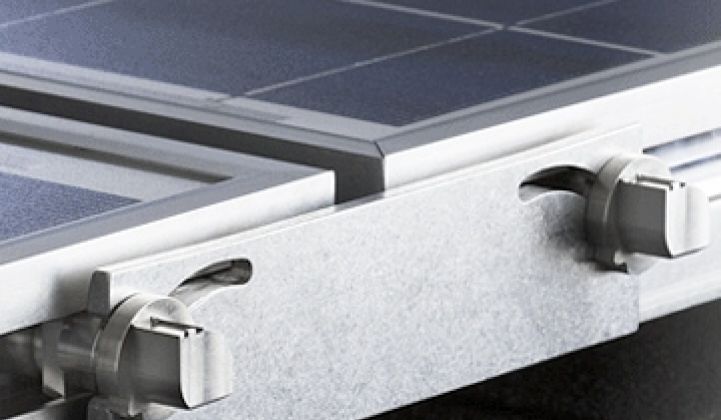There's a lot of metal in a solar array that doesn't need to be there, as far as Zep Solar is concerned.
The company, which spun out of High Sun Engineering, has come up with a mounting system that eliminates a significant amount of the racking required to erect a solar system and in turn lowers the cost. Zep claims it can trim the price of a solar system by 50 to 80 cents per watt, a sizeable discount. A University of California study stated that residential solar cost $5.40 a watt after installation and incentives in 2008 and many installers quote $7 to $6 per watt as the going price.
Additionally, modules employing Zep's mounting system can be installed onto a roof in four to six times less time, according to Christina Manansala, the vice president of operations. GroSolar, the prominent distributor and installer, has agreed to work with Zep. The coming-out party for Zep occurs later this week at Solar Power International.
Although it's not as glamorous as cell design or efficiency, installation is rapidly gaining more attention in the solar industry as a way to bring down costs and/or percolate demand. Installation can account for one-third of the cost of a solar project and in some ways it can be more difficult to control than manufacturing. The work ultimately has to be performed on location in varied conditions by people with a wide range of skills. Still, the "plumber's crack problem" is not the kind of research project that tends to attract DOE funds.
In recent years, Solar City, Sungevity and Global Solar Center have devised software that trim project planning and estimating costs. Akeena Solar and GreenRay have promoted all-in-one solar panels complete with inverters that reduce the amount of sawing and work that has to occur at a job site while Armageddon Energy has created an Ikea-like kit for assembling solar arrays in minutes. Home Depot is expected to put more emphasis on do-it-yourself kits. Another start-up, Sollega, has started to tout a one-piece rack from recycled plastic.
Large panel makers, meanwhile, are starting to tailor panels to particular roofs: module modularization like this echoes how the PC market evolved to better suit customer needs.
How does Zep's system work? Instead of mounting solar panels on the equivalent of a steel or aluminum coffee table, Zep props up on a device its calls the Interlock Zep. In layman's terms, the Interlock is essentially a leg that clamps onto the frame of a solar panel and serves to prop up the solar panel and fasten it to the other panels in the array. Instead of a table, you just buy the leg.
"You have to have a frame in the module so you already have a structure," said Manansala. "Why double up on it?"
The Interlock requires a special grooved frame. Zep, however, is already in negotiations with a couple of manufacturers on swapping out traditional frames with its grooved one. The grooved frame uses about the same amount of raw material, she added. The patents for the Interlock came though a little while ago.
Unlike Lighthammer Software, the company name was not coined as a tribute to Led Zeppelin. The founders wanted something short and "all of the good short words were taken," Manansala said. Zep just happened to be available.



